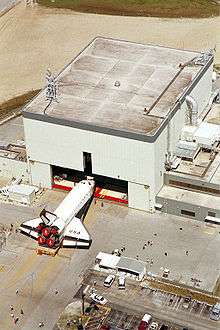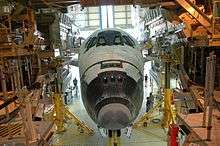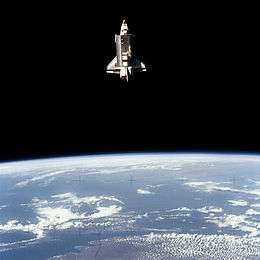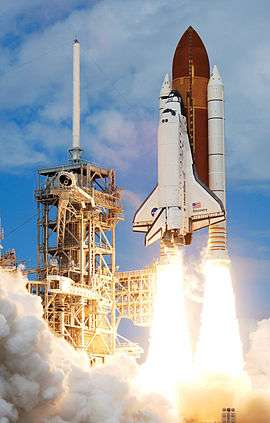Orbiter Processing Facility

An Orbiter Processing Facility (OPF) was one of three hangars where U.S. space shuttle orbiters underwent maintenance between flights. All three such facilities, OPF-1, OPF-2 and OPF-3, were located at NASA's Kennedy Space Center in Florida at Launch Complex 39.
They were located west of the Vehicle Assembly Building, where the orbiter was mated with its External Tank and Solid Rocket Boosters before transport to the launch pad. OPF-1 and OPF-2 are connected with a low bay between them, while OPF-3 is across the street.
OPF-3 was previously called the Orbiter Maintenance & Refurbishment Facility (OMRF), but was upgraded to a fully functioning OPF.
Processing flow
When a shuttle mission was completed, the orbiter was towed from the Shuttle Landing Facility to its assigned OPF where it spent several months (typically less than 100 days) being prepared for the next mission. Any remaining payloads from the previous mission were removed and the vehicle was fully inspected, tested, and refurbished.[1]
- The orbiter's main engines were purged to remove the moisture that was a by-product of liquid oxygen and liquid hydrogen combustion.
- payload bay doors were opened and any hazardous payloads were processed for safety
- fuel cells tanks were drained of remaining cryogenic reactants. The oxygen system was rendered inert with gaseous nitrogen and the hydrogen system with gaseous helium.
- high-pressure gases were vented from the environmental control and life support systems.
- refuse and other waste products including draining of the potable water system were offloaded
- heat shields were removed from the engines and aft access were opened
- main engines were locked in place and covers installed.
- scaffolding was installed around the orbiters aft to allow technicians to access the main engines
- main engines were removed and transferred to the Main Engine Processing Facility for checkout and service
- any needed repairs on the orbiter's thermal protection system including the thermal blankets and thousands of tiles were completed.[2]
- the Orbital Maneuvering System and Reaction Control System pods were possibly removed and transferred to the Hypergol Maintenance Facility for troubleshooting, repair or other services.
- any modifications to the orbiter were completed in the OPF.
- After all its flights, the orbiter went through "Down Mission Processing."
Prior to rollout to the Vehicle Assembly Building, several weeks before scheduled launch, the orbiter was prepared for the next mission by installing mission flight kits, payloads, consumable fluids and gases where possible. Remaining payloads, fuels and fluids were installed on the pad closer to launch day. The last step before rollover to the VAB was weighing the orbiter to determine its center of gravity.[1]
Orbiter assignments/OPF status
OPF-1 was closed following Atlantis' s rollout on June 29, 2012. In January 2014 it was announced that Boeing will lease the facility to enable the U.S. Air Force to efficiently land, recover, refurbish, and re-launch the X-37B unmanned spacecraft.[3] In October 2014, NASA announced the signed agreement for the use of the facility, and Boeing is planning construction upgrades on OPF-1 for the X-37B Program, targeted to be complete in December 2014.[4]
OPF-2 is now inactive following Atlantis's departure on October 18, 2012. In October 2014, NASA announced an agreement with the U.S. Air Force's X-37B Program to use OPF-2 in conjunction with OPF-1. Boeing is planning construction upgrades on OPF-2 for the X-37B Program, targeted to be complete in December 2014.
OPF-3 is under lease to Boeing for the manufacture and testing of their CST-100 spacecraft.[5]
Discovery is currently at the Steven F. Udvar-Hazy Center.
Endeavour arrived at the California Science Center on October 14, 2012.
Atlantis rolled out of OPF 2 for the final time on October 18, 2012 and was moved to the Kennedy Space Center Visitor Complex on November 2, 2012.
References
![]() This article incorporates public domain material from websites or documents of the National Aeronautics and Space Administration.
This article incorporates public domain material from websites or documents of the National Aeronautics and Space Administration.
- 1 2 "From Landing to Launch Orbiter Processing" (PDF). NASA Public Affairs Office.
- ↑ "Reliable Shuttle Orbiters Need Special Care". United Space Alliance.
- ↑ Boeing Expands at KSC To Support X-37B Program
- ↑ NASA Partners with X-37B Program for Use of Former Space Shuttle Hangars
- ↑ Boeing to Build Private Space Taxis in Old NASA Shuttle Hangar
External links
- Kennedy Space Center page on the Orbiter Processing Facility
- Orbiter Processing Facility Payload Processing and Support Capabilities Handbook
Coordinates: 28°35′09″N 80°39′18″W / 28.585803°N 80.654991°W



